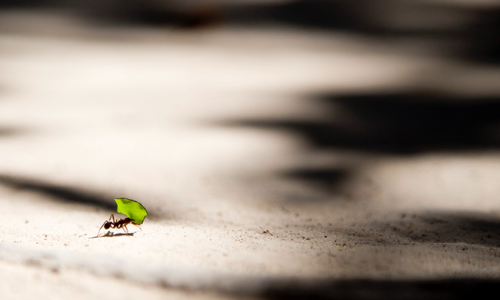Your PERSONAL ANT-CYCLOPEDIA
Argentine Ant (Linepithema Humile)
Argentine Ant Scientific Classification
Phylum Belonging: Arthropods
Class of Belonging: Insects
Order To Which It Belongs: Hymenoptera
Family In Which It Is Located: Formicidae
Subfamily In Which It Is Located: Dolichoderinae
Genus: Lineapithema
Species: Líneapithema Humilde

Post Audio Argentine Ant
The time has come to talk about one of the most interesting species of ants that exist in the world. I am referring, of course, to the Linepithema humile, better known as the Argentine ant (Common Name). Despite its name, it can make us think that it is native and comes from Argentina. The truth is that this is native to many countries. Some of them are:
- The North of Argentina
- Uruguay
- Paraguay
- Bolivia
- South of Brazil
A curious fact is that its scientific name changed. Previously it could be identified by the name Iridomyrmex humilis, but as in most cases in which a species is under constant analysis, its name ended up changing.
Among its most outstanding characteristics is that of being a highly invasive species and that, thanks to its ability to adapt to many climates and geographical areas, it was able to establish itself in areas that enjoy temperate climates, such as the Mediterranean climate.
The ways in which this incredible insect has been able to mobilize at so many latitudes is really interesting (we will discuss this in detail later). However, to give us an idea, the Argentine ant was initially introduced by accident because of us humans and can currently be found in countries such as:
- Easter Island
- continental United States
- South Africa
- New Zealand
- Japan
- Europe
- Australia
- Hawaii
A complete adventure for these interesting arthropods.
“Pest Stats”
| Color | Dark brown to black; shiny |
| Legs | 6 |
| Shape | Segmented; oval |
| Size | 1/16″ – 1/4″ |
| Antennae | Yes |
| Region | Mainly Southeastern U.S. States |
What do Argentine Ants Look Like?
Argentinean ants are light brown and range from 2.2 to 2.8 mm long. They’re wingless, with 12-segmented antennae, and emit a musty odor if crushed. Queens are slightly larger than the workers, at 4 to 6 mm long, but both reproduce reproductives (queens and males) are winged.
Description
In this area, worker ants fall into a very common order. For example, worker ants of this species can measure an average of 1.6 to 2.8 millimeters, which comes to about (0.06 to 0.11 inches) in total length, and can even slip easily into cracks and small holes. To give you an idea, these can fit into holes up to 1 millimeter (0.04 inches) in length.
In the case of queen ants. Studies have shown that these can grow to be 4.2 to 6.4 millimeters (0.17 to 0.25 inches) long. If we compare it with other species with similar characteristics to the Argentine ants, these are much smaller.
Another trait that I personally find very interesting about the Linepithema humile is its ability to create small vigil quarters in very varied areas, such as the floor, the space between the wooden boards of our house, and even cracks or Solid concrete walls. Practically these animals make their way to find the most advantageous areas in which they can protect themselves and watch.
But as we mentioned before, Argentine ants are known for their ability to conquer any geographical area and build to nest in natural areas. Generally in dry litter or small stones. The main reason for this is their inability to make deep nesting holes. But what for some is a disadvantage, for the Argentine ants, is a great advantage, since despite not being able to dig deep nests if they can take over much deeper abandoned nests dug by other colonies.
Geographical distribution
This is a somewhat complex question to answer because the Argentine ant has successfully spread and established itself in at least 15 countries around the world and at the same time in 6 continents, including oceanic islands. Only in the continental United States, we can find this invasive species in states like Arizona, Texas, or even Oklahoma. Below we offer a complete list of the states where this species is most common.
Argentine Ant Distribution Map In Us
This species is extremely common in many places in the southern United States. Although it is widely adapted to urban environments, the Argentine ant has also been observed outside of urban areas throughout the country.
Argentine Ant Arizona
Argentine Ant California Supercolony
Argentine Ants San Diego
Argentine Ant Florida
Argentine Ants Georgia
Argentine Ant Hawaii
Argentine Ants Los Angeles
Argentine Ants Michigan
Argentine Ant Supercolony Map California
Argentine Ants Oregon
Argentine Ants Ontario
Argentine Ants Oklahoma
Argentine Ants In Ohio
Argentine Ant Texas
Argentine Ants In California
Argentine Ant Arizona
Argentine Ant Map
On the other hand, this small insect has not only been interested in the United States since it has managed to move and colonize other latitudes. Beneath, we present you the entire list of countries and continents in which the Argentine ant is currently spread:
Argentine Ant Distribution By Country
Argentine Ant Australia (why was the argentine ant introduced to Australia?)
Argentine Ant South Africa
Argentine Ants India
Argentine Ant New Zealand
Argentine Ant Philippines
Argentine Ant Uk
Are Argentine Ants In Canada
Argentine Ant Argentina
Argentine Ant Uruguay
Argentine Ant Paraguay
Argentine Ant Bolivia
Argentine Ant Brazil
Argentine Ant Distribution By Continent
Argentine Ant Asia
Argentine Ant America
Argentine Ant Africa
Argentine Ant Europe



Join The Ant Farming Club!
If you are looking for an Ant Farm and you don’t know which one to choose, or on the other hand you already have your first ant farm, but you don’t know how to grow your colony, take care of it or feed it. Here we offer you the best tips and products to make your colony grow healthy and strong.
In the next section, you will also find advice from professionals to choose the best products on the market such as:
- Luminous Gel
- Ant Farm Sand
- LED light
- Live Ants
- Full Ant Farm Kits For Kids
Ant Farming Club is perfect for kids wanting their first ant farm or schoolteachers wanting to show their students the biology of ants in a natural habitat.
Join
Join and learn all about the world of ants and ant farming.
Products & Discounts
Find discounts and advice from professionals about the best products on the market in 2022.
Meet
Connect with people who are passionate about the world of entomology.
Do Argentine Ants Bite?
Luckily, this ant species don’t have a stinger like some others. The only serious threat these pests pose is to food sources. When searching for new food sources, Argentine ants will crawl into the smallest crannies and onto anything wet or decomposing, as well as over trash, sewage, and dead animals.
Argentine Ant Bites and Treatment
Typical symptoms associated with many ant bites and stings include localized hives. For example, “The fire ant” causes immediate, intense pain and a red welt that can last for hours or days. It is particularly typical for bites to be massed, specifically under clothes. Argentine ants are different because they do not inject venom into the skin, so they will not seem to cluster.
Allergic reactions to ant bites and stings
Generally, allergic reactions to Hymenoptera bites are milder than allergic reactions to Hymenoptera stings.
What is the treatment for ant bites/stings?
Treatment for ant bites/stings relies on the skin reaction’s severity. Get rid of ants from your skin and clean the affected zone with soap and water. Put a cold compress on the area to relieve itching and swelling.
Immediate Treatment management may include:
Oral antihistamines. These help with skin itching and hives.
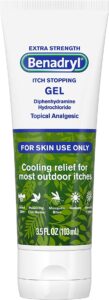
About this item
- Benadryl Extra-Strength Anti-Itch Gel temporarily relieves pain and itching associated with insect bites, minor burns, sunburn, minor skin irritations and rashes due to poison ivy, poison oak and poison sumac.
- Topical analgesic gel provides cooling, anti-itch relief from most minor pains and outdoor itches associated with insect bites.
- The cooling gel provides the relief of pain and itching associated with insect bites.

More Immediate Treatment management:
Analgesics
In case the inflammation takes a long time to reduce. Oral corticosteroids are recommended to reduce inflammation.
On The Other Hand…
Oral corticosteroids
In case the inflammation takes a long time to reduce. Oral corticosteroids are recommended to reduce inflammation.
Finally, one of the most effective treatments is Education. This will allow us to avoid dangerous insects and the areas where they live. If you have visible anthills in your home, avoid walking around barefoot. Always wear long pants and a long-sleeved shirt when doing outside activities.
Long-term Treatment management:
- Education is the key to avoiding these types of insects in areas where we know poisonous ants are prevalent.
- Use high shoes and socks as a priority when you decide to be outdoors.
- If you want to work in the garden and we are aware that we share our space with dangerous insects, always wear work gloves.

About this item
- Benadryl Extra-Strength Anti-Itch Gel temporarily relieves pain and itching associated with insect bites, minor burns, sunburn, minor skin irritations and rashes due to poison ivy, poison oak and poison sumac.
- Topical analgesic gel provides cooling, anti-itch relief from most minor pains and outdoor itches associated with insect bites.
- The cooling gel provides the relief of pain and itching associated with insect bites.

YOU CAN ALSO LISTEN HERE!
Audio Argentine Ant 2
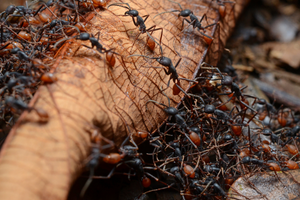
Natural Behavior
When we talk about Argentine ants, we necessarily have to talk about the enormous success this species has had due to its social behavior. Rarely has there been a record of attacks or competition between them. This differs greatly from most other ant species.
Suppose we want to address this phenomenon from a scientific perspective (which never hurts). Linepithema humile ants have a rare uniform genetic makeup. What allows many individuals of a specific colony to coexist and mix with other ants from neighboring nests. This allows them to live together without being attacked and takes their evolution to the next level by even allowing them to create so-called ‘super colonies of ants.’ Incredible true? Well, it gets even better.
This behavior is so common in species like the Argentine ant that the phenomenon even has its own name, Unicoloniality.
The Unicoloniality of ants is nothing more than individuals belonging to different colonies that, of their own free will, decide to mix between nests.
This type of social organization is a paradox of evolution and has been one of the key points for this species to have achieved ecological dominance in many geographical areas.
But not everything is rosy, as many experts consider this evolutionary behavior a potential problem. An example of this is the super colony discovered in the San Diego territory, which encompasses territories beyond San Francisco. In this area was located a population of ants that oscillated almost a billion individuals.

Funny Fact About Argentine Ants
How Do Ants Recognize Each Other?

Experiments have been carried out that seek to decipher why ants from different colonies would be able to coexist with each other, and it was concluded that ants with a similar diet, such as hydrocarbons, have a greater possibility of recognizing each other. as relatives. This results in individuals with dietary elements in common, often generating recognition signals among members of a super colony.
On the other hand, since we have mentioned its negative impact on native vegetation. It should be noted that Argentine ants tend to take care of colonies of other insects, such as:
- Aphids
- Mealybugs
- Larvae of other species
In this process, they sometimes relocate said parasites in vegetation that has not been affected by these animals (This practice benefits the ants since it allows them to feed on their excretions, known as “honeydew”).
This relocation also has a protective purpose, making it difficult for the predators of these parasites to feed and control the pests affecting agricultural areas. This means that damage to crops by parasites is sometimes associated with an increase in ants in the agricultural area.
Finally, there is evidence of a decrease in pollinating species by Argentine ants, which feed on their larvae.
Argentine Ant Photos And Pictures

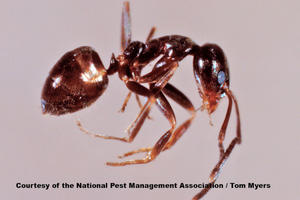

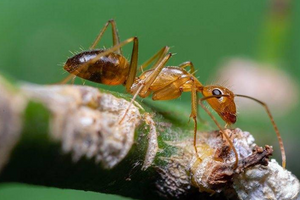

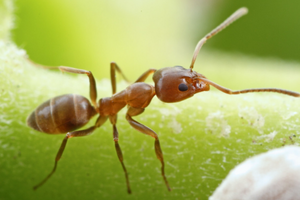
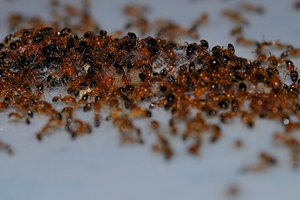

Seasonal Colony Trends [All You Should know]
Argentine Ant Reproduction (Reproductive Biology)
If you have read our ant blog before, you will know that queen ants are the only individuals in the colony able to reproduce. In the case of worker ants, they have different jobs, but they are not less important. These are in charge of directing the development of eggs toward reproductive individuals. In the case of males, the situation becomes a bit more complex since their development is associated with the larvae and their feeding. For example, a larva fed a lot of food will turn into a male in its adult stage. Finally, despite what we may believe otherwise, a colony has many queen ants. To be more specific, it could have up to 8 reproductive individuals per thousand workers.
L. humile is able to produce up to 3 different castes of progeny: The best known to all is that of workers and, of course, the males and the queens. These ants go through a process of metamorphosis that produces three types of immature forms:
- The egg
- The larvae
- And the pupae.
Their mating system is scientifically known as “Intranidal“. Which does not mean anything other than the nuptial flight, or in other words, these ants have mating flights, and finally the mating process is consummated in another nest.
When the process of fertilization of a virgin queen is complete, the worker ants will proceed to clip their wings (Although, in some cases, this is done by the same queen ant, who uses these to feed and thus produce eggs). This also allows the new queen the necessary ovarian maturation for egg production.
The diploid eggs (Fertilized Eggs) will finish their cycle, becoming mature females (both workers and queen ants), and the individuals that are not subjected to the fertilization process (Haploid Eggs) will become males.
The seasonal event known as “The Seasonal Low.” It is nothing more than an exact moment of the year in which a colony is made up of 90% worker ants. This phenomenon usually happens in the middle of winter (the remaining 10% is made up of queens). One of the main characteristics of this event is the lack of reproductive activity, so the total number of new births is almost non-existent. Once the winter is over, eggs begin to be produced, and almost all new litter will hatch into their adult forms around May.
Between the different adult members, mating will take place, and the production of workers will increase between March and October. Still, this number is not replenished, so the total volume of ants constantly falls during winter, and the cycle repeats itself.
Another characteristic of behavior in this type of ant is their ability to generate territorial borders the more they expand. These borders can expand or contract depending on the season and atmospheric conditions. For example, during the summer months, these borders tend to expand and contract during the winter months. Scientists have detected that this mainly affects soil moisture and temperature. On the other side of these borders are rival ants and other obstacles to their development, such as predators or inhospitable environments.
Impact
In order to cover the subject of the individual impact that Argentine ants have, it is first necessary to clarify that there is a list of invasive species on the planet. Among these species, ants as arthropods are among the 100 worst species on record.
In the specific case of the Argentine ant, its status as an introduced species makes it a displacing individual of the most significant number of other native ant species. There is a record of its potential threat to other native invertebrates. But we must not only talk about the other invertebrates but also affects small vertebrates with the little evolutionary capacity to defend themselves against aggressive ants.
This situation has the potential to endanger the ecosystem itself. A more detailed example of this would be the native vegetation itself since these have a mutualistic relationship with the species of ants and native insects for seed dispersal or, for example, the other animals that feed on said animals.
One event to study would be the severe decline in the population of horned lizards off the southern coast of California. In recent studies, it is known that this displacement is directly correlated with the expulsion by Argentine ants of the native ants that serve as the base of their food.
YOU CAN ALSO LISTEN HERE!
Post Audio Argentine Ant 3
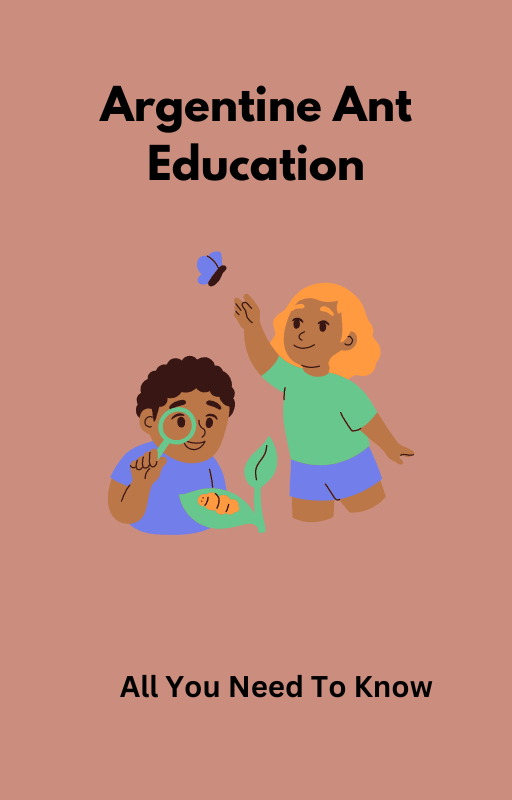


Argentine Ant Education (Argentine Ant Life Cycle)
Habits
Like many species of ants, Argentine ants have a reputation for being highly efficient in following trails in search of food and adaptation. For example, queens have been known to produce pheromones on their way back to the colony once they have located a large food source. This characteristic feature ensures no time is wasted relocating a previously set road.
Among the foods that cause greater interest in this type of ant are those rich in sugar; however, during the reproduction period, this diet changes drastically to become a diet rich in animal protein.
And since we mentioned our friend, the Argentine queen ant. I find it interesting to cover a bit of its counterpart, the male ant. This individual of the colony is very interesting since it has a single purpose. This must mate with the queen ant to populate the colony. It could be said that mating is its only reason for existing, and that is why this ant has the shortest life expectancy of all. We are talking about a life expectancy of around a year, which will end after mating.
Once the eggs have been laid by the queen ant. Many sterile workers will begin to hatch. Among his most notable responsibilities are the following:
- The search for food both for themselves and for the queen ant
- Care of the eggs and young larvae
- And, of course, the feeding of the baby ants
Not all ants build new nests through swarms. Argentine ants need budding to reproduce, a known process in which queens and males mate inside the nest. Once this cycle is complete, it allows them to migrate and continue directing the process from another side until they create a new colony. These networks of nests with interlocking links can spread out to form giant colonies.
Habitat
Argentine ants like to live in moist environments near places with plenty of food to build a low nest under boards or stones or along the garden. When the weather is not favorable, and there are many extreme temperatures, humans often notice that ants tend to invade buildings with great ease and will continue to live near moisture inside trim such as water pipes, sinks, or potted seedlings. The common way that ants enter a home is by crawling through the trees through the area next to utility lines that touch the building.
Threats To Humans (Are Argentine ants harmful?)
Argentine ants do not pose an extreme health threat; however, some Argentine ants have been known to crawl over sewage, garbage, and dead animals while foraging for food. They can contaminate food if they build nests in a home’s kitchen and become pests of chicks and beehives. However, these are just some general examples they share with other insect species and should not be attributed solely to ants.
Environmental Requirements
Due to its origin, this ant strongly prefers temperate climates. To be more specific, we are talking about controlled humidity levels. Various investigations have confirmed that both dry spaces and those with a higher-than-normal level of humidity limit their territorial expansion.
Another factor that can play against them is the temperature of the environment.
(Maximum temperature 34ºC)
(Minimum temperature 5ºC)
Nutrition And Diet
Like the vast majority of ants, Argentine ants are omnivores, meaning they are creatures whose basic diet is composed of almost any food. However, as we have previously mentioned, they highly prefer sugary foods.
Nests and Colonies
Argentine ants do not implant new nests by swarming, unlike many other species that establish nuptial swarms during seasonal changes. In the case of Argentine ants, the producing queens mate inside the nest. One of the most important reasons is due to the outside temperatures.
Once mated, the queen ant will move forward and leave the nest on foot to find her new colony. This new colony will develop near the main colony to maintain a direct connection to the old colony of the new queen. This allows, in some cases, the members of both colonies to coexist, and even the workers are shared between anthills.
Argentine Ant Queens
Argentine ant queens are different from other ant species. Some of the differences include the following:
Argentine Ant queens are relatively small compared to other ant species, only about 1/6 – 1/4 inch in length.
Winged Argentine ants prefer to mate once with a winged male and then can continually produce fertile eggs for their whole lives. In contrast, other ant species will participate in swarming flights every season and build new nests. These Argentine ants mate inside the nest and never swarm.
Argentine ants have several queens, each capable of laying as many as 60 eggs daily.
Argentine ant queens do more than lay eggs. They also feed and care for the ant workers’ young with their bodily fluids. It’s not uncommon for other ant queens to primarily lay eggs and leave it up to the workers to feed and care for them.
Unlike other ant queens, Argentine ant queens are mobile. They can be seen outside the nest along with workers, and they can move if conditions become too difficult. This enables the short-burst establishment of new nests if necessary.
The Best Products 2023
Formicarium
Formicarium
Ant Farm
Ecosystem
Entomology supplies
Test Tube Packs
Pipettes
Feeding Dishes
Ant Foods
Ant Nectar
Feeders
Eco-Fresh Rice Worms
Fly Larvae
Kits
Terrarios
Nest Kit
Ant Farm Sand
Ant Farm Neon Gel
YOU CAN ALSO LISTEN HERE!
Post Audio Argentine Ant 4
Argentine Ant Pest Prevention & Control
Have you ever felt that a small trail of ants spread little by little to the point where you find these little insects everywhere? It all started with a trail of Argentine ants that spread through the trees in your garden, but now they get everywhere, including the walls and even your vehicles. If you feel identified with this and want to know the best ways to control these pests without the use of expensive pesticides that could not only harm other insects and animals in your garden but could even be harmful to your pets and family, read on. since next we will offer you the best tips to keep Argentine ants away from your home.
Prevention
That said, there are different ways you could protect your property from Argentine ants. But for this, we need to know their behavior to use it against them. An example of this would be their natural attraction to moisture and, obviously, to food sources.
If we want to avoid Argentine ants, it will be necessary to prioritize the elimination of sources of stagnant water in areas such as:
- Birdbaths
- Large pots
- Grills
- Or even Swimming pools
Once the ants are not able to locate sources of drinking water easily, they will think of moving the nest to another area. This may take time, but if we manage to eradicate the sources of stagnant water, we will be hitting them hard without hurting them.
On the other hand, a second step that we could follow would be to maintain total control of food spills and the use of containers for the hermetic storage of food. If we constantly eliminate food waste in our homes, we will be taking away the food sources that attract them to our homes.
A cause of Argentine ants in our home that we rarely take into consideration is the natural bridges to our home. The Argentine ants take advantage of the trees to make their nests, and if these trees have long branches that are in contact with the structure of our home, they will possibly serve as bridges to enter our house with ease. Many times, pest controllers have detected ant trails that begin on tree branches near the structure.
And since we mentioned this, it is also necessary to check for potential cracks or small openings in the foundation of the property. These can also serve as entryways. (A tip in case the ants are using these means to enter our house is to use Sealant or resins to cover the holes).
Finally, to prevent Argentine ants in your home, we recommend that you need to store materials such as lumber for firewood or construction material. That you do it within 20 feet of your house, as well as remove yard waste like grass or old branches regularly.
Wanna learn more about Ants? Join an Online Community of more than 1000 Readers Around the Country.
Here you can sign in to our newsletter to receive daily emails with funny facts, interesting details about ants, step-by-step tutorials, and even good practices to have a healthy ant farm colony. We’ll be more than happy to have you in…

How to Get Rid of Argentine Ants (Easy Steps)
1 – First Step: Inspection & Control
- Have you ever tried to kill a group of Argentine ants, only to find that they have recovered and now there are more ants than before? This is because this species of ants is highly complicated to eliminate due to its ability to reproduce and establish extremely dense colonies.
- Trying to kill them manually is indeed the wrong way to deal with the problem. Instead, the first thing to do is locate the source of the infestation. Whether inside our house, basement, attic, or even the garden. The first thing we must do is find the origin of our new tenants.
- Once we have identified the area where the largest number of ants reside, we can implement a series of natural or chemical strategies to eradicate them and keep them at bay. In this section, we will cover both.
2 – Second Step: Natural Methods To get rid of Argentine Ants
Outdoor And Indoor Organic Pest Control Products
Diatomaceous Earth
Diatomaceous Earth is a naturally occurring soft sedimentary rock that has been ground down to a fine white powder.
This powder damages the exoskeleton of insects, so it acts as a barrier that Argentine ants won’t cross.
If you have potted plants on a shelf, you can put a small amount of diatomaceous earth down by the legs of the shelf, preventing ants from getting up onto the plants.
These barriers can be put virtually anywhere, both indoors and outdoors.
While Diatomaceous earth is safe for humans to handle and even eat, it does create fine dust that should not be inhaled.
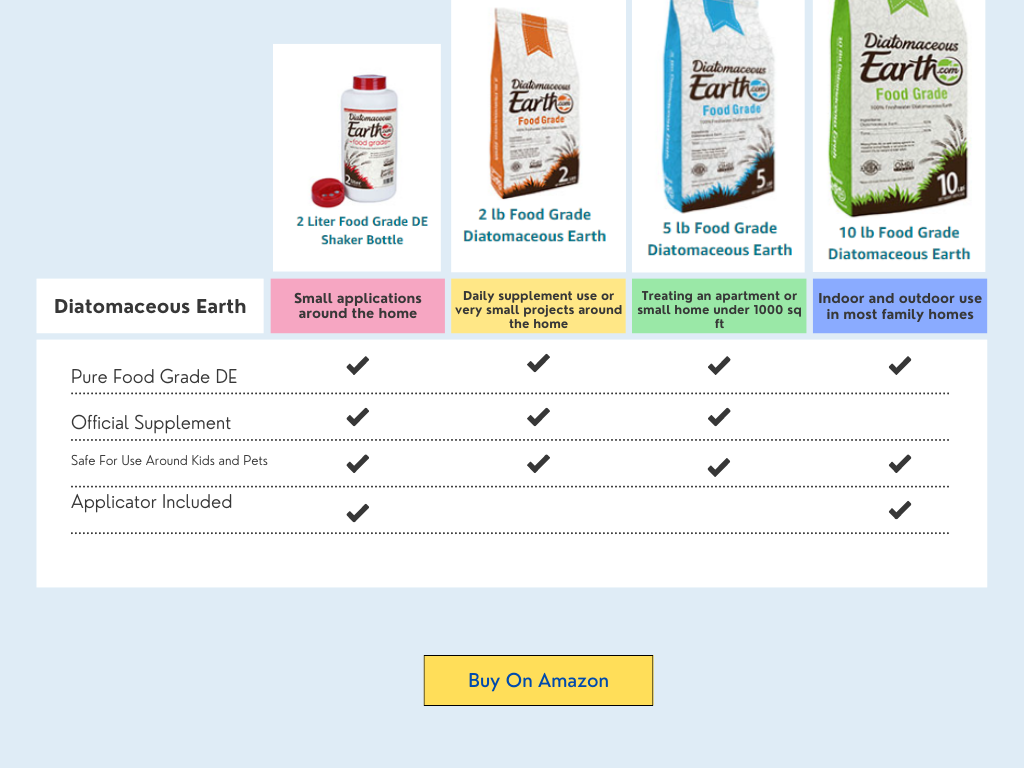
PROS About Diatomaceous Earth
Among its most striking advantages is the low risk to the health of people, children, and pets, as well as the residual years that this compound can have in our home, providing extra protection against pests. This material is not recommended for use on carpets or floors that you would vacuum.
CONS About Diatomaceous Earth
Although this product represents a non-chemical solution to avoid chemical pesticides. This powder can have some drawbacks. An example of this is that insects need to have direct contact with the material, as well as prolonged contact for it to have a greater effect. This means, that if we decide to use this. We must distribute it throughout our home in large quantities. On the other hand, Diatomaceous Earth must be kept dry, so it is not a good idea if we want to use it in our gardens that are damp from irrigation.
Despite its low toxicity. This material could not be used to kill ants if it did not have some level of danger to the health of insects, so the use of dust masks is recommended, as well as applying it in ventilated areas since this dust could cling to the mucous membranes of the nose and mouth. Also, the dust could fly and generate allergies if we apply it in places where there are fans or air conditioning.
Boric Acid
Boric Acid is a type of Acid found in many naturally occurring minerals, such as borax. Borax is found in many cleaning products, including some types of toothpaste.
Boric Acid has a very low toxicity level for mammals but not for ants. It interferes with their digestive system and slowly terminates them.
The trick is to keep the level of boric Acid low enough so that it travels through the colony and makes it to the queens and young before killing the ants.
I will give you a personal recommendation of a product that is currently on the market called Terro. This contains borax, and I found it effective against argentine ants.
You can also find recipes online to make your own bait at home using borax. (Here are the steps if you are interested)

PROS About Boric Acid
This product dissolves easily in water, which allows us significant savings. On the other hand, it is more granular than powder. Which makes it less likely that we will inhale it by mistake.
It is useful for other types of pests, such as cockroaches.
CONS About Boric Acid
In very humid climates, if not stored properly, it can become damp and ruined. Therefore, it is recommended to store the mixture in a gallon Ziploc bag to keep it dry and protected when not in use.
Essential oils
Argentine ants communicate with each other using pheromones. A forager that finds food marks a trail on the way back to the colony. This scent trail is followed by other ants, and these ants then reinforce the trail when they head back to the colony with food.
Pheromones also help ants tell each other apart, warn each other of danger and communicate all sorts of messages we’re only beginning to understand.
Most essential oils have a very strong fragrance. We can use this strong fragrance to mask pheromone trails and disrupt the coordination of ants. This method, in addition to being very efficient, allows you to drive away the ants in a natural way without causing them harm.
Essential oils can be added to soapy water that can be used to clean pots and shelves where we keep cacti and succulents. This will mask any previous messages ants left behind to tell other ants… HEY! There is a good food source, water, or shelter.
My Favorite essential oils to use for ants are:
- Peppermint
- Cedarwood
- Lemongrass and
- Clover
However, there is a high range of essential oils that we can use to keep ants away from our homes. Below we offer you a select list of the most efficient oils with the best results on the market.

Pros About Essential Oils
These essential oils represent rapid elimination and residual repellency. which means many months of additional protection.
On the other hand, this represents a highly respectful pest control with our environment.
In the case of living with other beneficial insects for us, such as bees or other pest-control insects. These represent minimal risk.
Finally, as we all know. Essential oils offer us a natural and pleasant fragrance for our home.
Cons About Essential Oils
Essential oils are very useful for many purposes despite their effectiveness in pest control. We may need large amounts to eradicate large ant colonies. Essential oils are expensive, so it can cost us a few dollars to completely eradicate an ant colony.
3 – Third Step: Insecticides and Ant Baits To Control Argentine Ant (Best Argentine Ant Killer)
Best Ant Bait For Argentine Ants
There are two types of baits to eliminate ants.
Fast Acting Bait: This will kill ants immediately. It is very useful if we want to eliminate a problem immediately. But the biggest quick problem is that just eliminated our immediate problem. The ants in the colony will not be affected by it.
Slow-acting bait: On the other hand, if what we want is for the worker ants to take our bait to their nests to feed the colony and the queen, our best option will be the slow-acting ones.
Among the most varied options on the market are:
- Baits (protein/fat-based baits).
- Honeydew Aphid Baits
- nectar baits
- Plant product baits as well as sugary carbohydrates.
In order to choose our best option, it is necessary to know well the nutritional needs of the colony and the type of ant to attack.
Sugar feeding cycles
The Ant Gel bait has a highly attractive formulation and is effective against all major ant species. Plus, it’s optimal for when ants are feeding on sugar.
Optigard Ant Bait Gel is a slow-acting, non-repellent ant bait that is effective for indoor and outdoor ants. The active ingredient, thiamethoxam, kills the queen and the worker ants, but the slower action means the treatment can go deeper into the nest than before. Optigard Ant Bait Gel does not have any of the unpleasant yellow-brown color or runny consistency of other bait products.
Protein/Fat Feeding Cycles
Invict Blitz is a bait-based protein that’s specially formulated to withstand harsh conditions in ant colonies. Invict Blitz can be used on: Argentine ants, Rasberry Crazy ants, Caribbean ants, and Big-Headed ants.
We recommend Sweet and Protein feed cycles for Argentine ants.
When you’re not sure what to choose, choose from each category.
The package that offers the best combination of value for money is the Mega-Colony Ant Kit. This kit contains Advion Ant Gel, Invict Xpress, and Prime Source Imidacloprid 2F, which provides coverage for both indoor and outdoor use. It also protects from various ant species. Prime Source Imidacloprid 2F is also non-repellent, meaning ants won’t be scared away as they are feeding.
Your content goes here. Edit or remove this text inline or in the module Content settings. You can also style every aspect of this content in the module Design settings and even apply custom CSS to this text in the module Advanced settings.
Argentine Ants Control Using Insecticides
In order to explain in detail the impact that aerosols and other types of insecticides have on ant colonies, it is first necessary to explain a concept called budding.
Budding is the process of dispersal of insects into sub-colonies that occurs when aerosols or residual powders are used. We may initially consider this to be a good thing, however, it multiplies the number of colonies, as well as our pest problem.
If we want to use effective chemical insecticides. We must think of other types of strategies, for example, baits.
Pesticide
Argentine Ants Control Using Pesticides
1 – The best outside pesticides for Argentine Ant control are non-repellant insecticides like Navigator SC and Imidaclorprid 2F. You should use Imidaclorprid 2F as both a perimeter treatment and to spray the foliage, turf, flower beds, and groundcover.
2 – If you are dealing with Argentine Ants, you’d typically spray the perimeter of your home with Navigator SC. This is usually enough to keep them from getting in and causing problems. If you need any insecticide inside, then use Spectre PS Aerosol in cracks and crevices.
3 – Non-repellent insecticides are great for ants and termites because insects that are in the area can’t detect it. Non-repellents also won’t be smelled, tasted, or even felt by Argentine Ants.
4 – Generally speaking, using a non-repellent insecticide such as Navigator or Spectre PS with a good mega ant colony bait like Invict Blitz is preferable because they don’t conflict with each other. Repellents often work against the baits in a mixture, rendering them less effective.
Subfamilies Of Ants
View More
View More
Ant SubFamily Group 3
View More

Did You Know That…
Over the last several months, we have found that baby powder creates an effective barrier against ants. Another product that is highly efficient is cornstarch and olive oil. Ants don’t really like olive oil, but you have to apply it to a relatively smooth surface within 1/2″ to 1″ that has no breaks for them to get through.
YOU CAN ALSO LISTEN HERE!
Argentine Ant Post 5
How to Raise an Argentine Ant Colony? The Ultimate Guide
Finally, we will close this article with one of my favorite sections. If you are like us, you may have wondered what it would be like to have your own colony of Argentine ants. And I’m glad you ask this question because, for many people, this would be something unusual; however, we are not like many people; we are fans of ants.
Next, we will teach you how to start your own ant colony, feed your ants, grow the colony, and even take better care of your new family. By the end of this article, I promise you’ll be an ant care pro and understand why millions of us have decided to collect these amazing animals.
Chapter 1: Getting Started in Argentine Ant Keeping!
Over the years, one of the most frequently asked questions is, what is a good ant species to start with? And the answer to this simple question is just as simple. We advise you to get any ant that lives around your house.
Because? The number one reason is the weather. One of the number 1 mistakes new ant collectors make is buying ants on sale pages simply because they seem interesting or we like their appearance. But the truth is that ants are delicate animals that can be affected by factors such as food, water quality, or climate. If we buy an ant that eats specific foods or lives in particular environments, we will have many problems with its development, and it could even die.
Another reason that is one of the most important is that if we get tired or consider that, we cannot have our ants with us. We can release them in the garden, and they will continue their development without negatively impacting the environment or local fauna.
That said… To start, we need a queen ant, which will lay all the eggs and keep the colony growing for years.
How to get an Argentine queen ant?
Let’s say you want an Argentine ant farm since this article is about Argentine ants. In this case, we first need to know the correct time of the year when the Argentine ants leave the nest in search of a new colony. As mentioned in previous sections, queen ants have times of the year when they come out to colonize. This is known as ant day and varies depending on the species. In the case of Argentine ants, their migrations will take place in spring when the area is very dry, but if the area is humid and rainy, the other hand, it will be during the summer.
How to identify an Argentine queen ant?
– Queen ants have wings during the colonization period.
– If they have already lost their wings, they can also be identified by their size, which is larger than the other Argentine ants.
– The section of the thorax is regularly more prominent.
– You must remember that an ant with wings has not yet mated, so if you have identified an area with queen ants, you should let them mate, and when they have lost their wings, they will be ready to be captured.
Time for a queen ant to start a new colony
Once the new queen is ready to find a new colony, it will wander. This will start a wander between holes and cracks. This unusual behavior means it is looking for the right place to start the colony.
As we already mentioned, another positive sign is if it has lost its wings.
Capture the Argentine queen with care.
The essential thing at this point is the delicacy of handling the queen ant. For example, a photographic roll or a test tube would be suitable places to transport it to its new home.
We will have to ensure that our ant has enough water through a wet cotton ball.
It will also help us to take a few tablespoons of soil belonging to the area where we found our Argentine queen so that she feels more comfortable.
How to feed your ants
Argentine ants are one of the most popular species to keep as pets. They are relatively easy to care for and interesting creatures to watch. One of the most important things to remember when raising an Argentine ant colony is how to feed your ants.
Ants are small creatures and need very little food to survive. A single ant can live on a few crumbs a day. However, when you have a full colony of ants, they will need more food than that. The best way to feed your Argentine ant colony is to provide them with a varied diet that includes protein and carbohydrates.
An easy way to do this is to offer them small pieces of fruit or vegetables and high-protein foods, such as cooked chicken or hard-boiled eggs. You can also buy special ant pellets containing all the necessary nutrients. Whichever method you choose, ensure plenty of fresh water is always available for your ants to drink.
Grow the colony and take even better care of your new family.
For your colony to grow, you must take good care of your new family. Here are some tips on how to do this:
1. Provide them with a good food source. Argentine ants love sweets, so sugar water or honey would be a good choice. You can also offer them small insects or other sources of protein.
2. Keep your environment clean. This means removing dead insects or other debris from their nest regularly.
3. Make sure they have access to water. Argentine ants need to drink water regularly, so give them a small water dish or spray their nest frequently.
4. Give them a place to hide. Argentine ants like to hide from the light, so offer them a dark place to retreat to when they feel threatened. This could be a small box or container placed in their nest area.
I am starting the breeding of Argentine ants!
Assuming you’re starting with a single queen, there are a few key things you’ll need to do to get your Argentine ant colony off to a good start. First, you must find or build a suitable nest for your colony. This can be as simple as using a plastic container with holes punched in the sides for ventilation. You’ll also need to provide your ants with a reliable water source, ideally in the form of a small water dish or a water-soaked sponge.
Once you’ve taken care of their basic needs, you’ll need to feed your ants. Argentine ants are omnivorous so they will eat almost anything. However, for best results, it is recommended that you provide them with a diet that includes protein and carbohydrates. Some good protein sources for Argentina ants include live insects, cooked meat, and dry cat food. As for carbohydrates, they will enjoy molasses (a type of melon), sugar water, and fruit juices.
As your colony grows, you will need to watch for signs of breeding. Once your colony has several hundred workers and a handful of young (eggs and larvae), the queen will likely start laying eggs at an accelerated rate. At this point, consider moving your colony to a larger enclosure so they have more room to grow. Congratulations, you are now the proud owner of an Argentine ant colony!

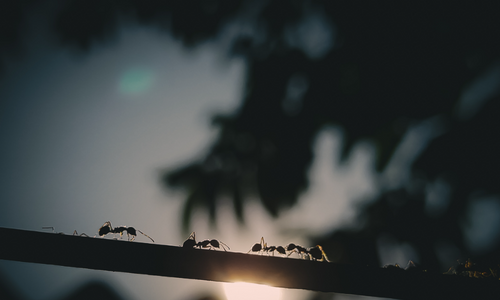


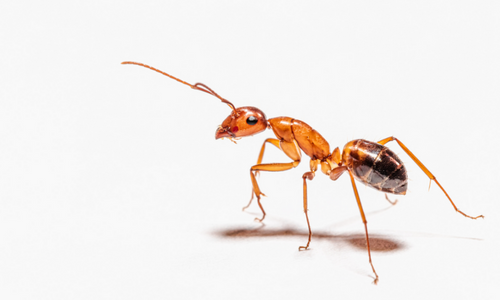
The Best Products 2023
Formicarium
Formicarium
Ant Farm
Ecosystem
Entomology supplies
Test Tube Packs
Pipettes
Feeding Dishes
Ant Foods
Ant Nectar
Feeders
Eco-Fresh Rice Worms
Fly Larvae
Kits
Terrarios
Nest Kit
Ant Farm Sand
Ant Farm Neon Gel
Ant Farm Ecosystems
| Ant Farm For Classroom | Light-up Ant Habitat |
| Ant House With Feeding Area | Wall Hanging Ant Farm |
| An ecosystem with live ants | Ant farm for Preschool |
| Pet Anthill Ant House | Nest Insect Castle |
| Glow In The Dark Ant Farm | Aquariums For Ants |
| Ant Farm With Instructions | Ant Farm With Queen |
| LED Ant Farm for Live Ants | Connectable Ant Farm |
| Ant Farm For Kids | New Large Plaster Ant Farm |
| Pocket colony | Ant Farm With Queen |
Ant Farm Supplies
| Feeder | Feeding Area |
| Tunneling sand | Tunnel starter tool |
| Ecological Ant farm gel | Ants farming aphids |
| Nutrition and Care | Ants farming mushrooms |
| Ecological blue gel | Fungus for ant farms |
| Handcrafted Wood | Ant habitats |
| Ant Plastic Tubes | Ant Glass Tubes |
| Food for ants | Ant Farm Nectar |
| Ant Farm Live Insects | More Supplies |
Live Ants For Sale
| Live Ants | Best ant species |
| Coolest Ants To Keep | Interesting Ants |
| Fungus-farming ants | Exotic ants |
| Big Ants | Buy Queen Ant |
| Buy Worker Ants | Buy Soldier Ants |
| Domestic ants | Fungus farming ants |









